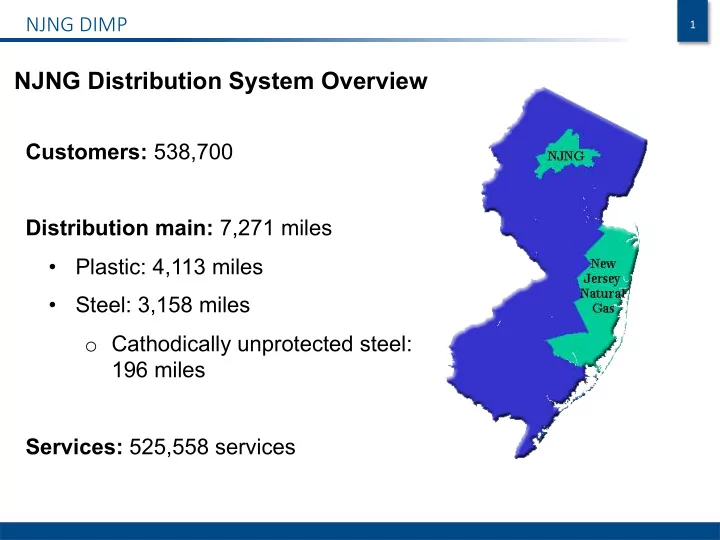

NJNG DIMP 1 NJNG Distribution System Overview Customers: 538,700 Distribution main: 7,271 miles • Plastic: 4,113 miles • Steel: 3,158 miles o Cathodically unprotected steel: 196 miles Services: 525,558 services
NJNG DIMP 2 History of DIMP • PHMSA implemented integrity management (“IM”) regulations for gas transmission pipelines in 2004. These regulations aimed to assure transmission pipeline integrity and further improve pipeline safety. • On December 4, 2009, PHMSA published the final rule establishing integrity management regulations for gas distribution pipeline systems. • Final Rule implemented August, 2011 Rule Summary • Identify existing and potential threats, Evaluate and rank risk. • Identify and implement measures to address risks • Measure IM program performance, monitor results, and evaluate effectiveness • Periodically assess and improve the IM program • Report performance results to PHMSA and State pipeline safety regulators
NJNG DIMP 3 How NJNG Applies DIMP NJNG DIM Program • The DIMP is the overall approach by NJNG to ensure the integrity of its gas distribution system. • This approach includes: • Identifying distribution system threats • Performing distribution risk assessments • Identifying measures to reduce distribution risk • Using performance measures to gauge DIM Program effectiveness
NJNG DIMP 4 How NJNG Applies DIMP • Risk Assessments Highlight Top Risks - Corrosion Leaks - Excavation Damages • Measures To Reduce Risks Are Identified - Accelerated Bare Steel Replacement Programs - Damage Prevention and Public Awareness Programs • Performance Measures Gauge Effectiveness - Corrosion Leaks per Metallic Facility Mile - Excavation Damages per 1000 Tickets
NJNG DIMP 5 NJNG DIMP Risk Assessment Models Asset Class-Based Relative Risk Model • Provides high-level (Top 15) risk ranking by threat category. • Uses SME input from the Operations, Engineering and Corrosion. • Incorporates the previous 5 years of NJNG leak data. • Includes 20 years of national gas incident data. Segment-Based Relative Risk Model • Software running within GIS system provides risk ranking at the gas main segment level for replacement prioritization. • This risk assessment is run annually and results are shared with Engineering for replacement prioritization
NJNG DIMP 6 NJNG Accelerated Infrastructure Replacement and Enhancement Programs SAFE I SAFE II IIP NJ RISE March 2012 November 2015 February 2019 September 2013 1. SAFE I : Safety Acceleration and Facility Enhancement I 2. NJ RISE : New Jersey Reinvestment in System Enhancements 3. SAFE II : Safety Acceleration and Facility Enhancement II 4. IIP : Infrastructure Investment Program These programs help mitigate Corrosion and Natural Forces threats.
NJNG DIMP 7 SAFE I - Safety Acceleration and Facility Enhancement I • 5 year capital investment program (approx. $204 million) Started 2012 - Replaced 66 miles of cast iron main ( 100% of total population) - Replaced 278 miles of unprotected steel main ü Eliminated cast iron in 2015 ü Reduced Corrosion related leaks
NJNG DIMP 8 NJ RISE - NJ Reinvestment in System Enhancements • 5 year capital investment program (approx. $102.5 million) started 2013 • Projects: • Install approx. 30,000 excess flow valves (EFVs) in coastal communities to mitigate storm effects • Reconstruct and/or relocate 3 distribution regulator stations on barrier islands to mitigate flooding impacts • Install 4 secondary distribution mains from mainland to barrier islands for system reinforcement
NJNG DIMP 9 SAFE II - Safety Acceleration and Facility Enhancement II • 5 year capital investment program (approx. $200 million) • Replacement Projects : • Replace all remaining unprotected steel main and associated services ( 100% of approx. 276 miles) • Reduced corrosion leaks per metallic facility mile
NJNG DIMP 10 NJNG Risk Reduction CI/Bare Steel Inventory Leaks per Mile of System 600 0.2 0.18 500 0.16 0.14 400 0.12 300 0.1 0.08 200 0.06 100 0.04 0.02 0 2010 2011 2012 2013 2014 2015 2016 2017 2018 0 Cast Iron Bare Steel
NJNG DIMP 11 NJNG – Corrosion Leaks per Metallic Facility Mile 0.30 Corrosion Leaks per Metallic Facility Mile 0.25 0.20 Baseline: 0.15 Total Corrosion Leaks per Metallic Facility Mile 0.15 0.10 Baseline: 0.07 0.05 Hazardous Corrosion Leaks per Metallic Facility Mile 0.00 2011 2012 2013 2014 2015 2016 2017 2018 Total Corrosion Leaks per Metallic Facility Mile Hazardous Corrosion Leaks per Metallic Facility Mile Baseline (5 year rolling average)
NJNG DIMP 12 Excavation Damage Prevention Action Items • Provided Partners in Safety training for excavators within our service territory • Hold “Dig Safely” fairs at various locations to educate general population in damage prevention and natural gas safety • Invite excavators to breakfast seminars to update on current 811 updates and other locating changes • Dedicated department to locating inspections and excavator damage oversight and random quality audits • Participate in regional CGA chapter and propagate Damage Prevention Best Practices
NJNG DIMP 13 NJNG – Excavation Damages per 1000 One Call Tickets 3.80 Excavation Damages per 1000 3.60 3.40 3.20 Tickets Baseline: 3.16 3.00 2.80 2.60 2.40 2.20 2.00 2011 2012 2013 2014 2015 2016 2017 2018 Excavation Damages per 1000 Tickets Baseline (5 year rolling average) Note: Hurricane Sandy made landfall in New Jersey on October 29, 2012. Subsequent repairs contributed to an increase in excavation damages.
NJNG DIMP 14 DIMP Benefits • DIMP provides a structured approach to accurately identify and effectively mitigate distribution system threats • Continuous monitoring of leak data and performance measures allows NJNG to clearly see deviations and address issues accordingly • This has helped us achieve the lowest leak ratio in the state • There were 2,000 less leak calls in our fiscal year 2019 than in 2018 • Educating the public regarding proper locating has reduced excavation damages • Over 30% reduction in 3 rd party damages since the inception of DIMP
Recommend
More recommend